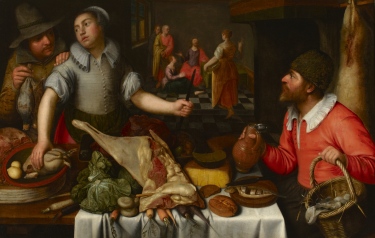
At first glance this intriguing painting appears to concern itself primarily with the presentation of food. The artist has depicted a range of wholesome foodstuffs along the front of the canvas, tantalizingly framed against various backdrops.
A servant girl, seemingly about to carve a chicken, is interrupted by a young man carrying a brace of partridges whilst a man holding a basket of eggs and a flagon of ale looks on attentively. However, the key to this painting relates to what is happening in the background. Engelszen uses several tricks to draw our eye towards the rear of the canvas, where the real story is taking place.
During the Italian Renaissance artists experimented with the use of perspective to add the impression of depth to a flat canvas but also to draw the viewer’s gaze towards important elements of the composition. The scene in the rear is framed by the walls and window and the black and white tiles on the floor lead the eye upwards towards the figure of Jesus Christ. Two other clues point to the significance of Jesus as the pivotal character in this scene. The servant girl’s knife points directly towards Jesus’s heart. The eyeline of the man with the flagon also leads directly towards the seated Jesus.
The story relates to a passage in the bible from Luke (10;38-42) in which Jesus visits the house of Mary and Martha. Martha, concerned with the urgency of household tasks, rebukes her sister for attentively listening to Jesus and ignoring her duties. The scene is captured at the very moment in which Jesus responds to Martha with the words “you are worried and upset about many things, but few things are needed… Mary has chosen what is better, and it will not be taken away from her.” The story reminds the viewer to follow this example and not to succumb to the temptations of the material world. This parable is followed by many people during Lent.
Engelsz was born in the Southern Dutch town of Gouda. He painted many religious scenes and, as was fashionable in the Low Countries during the seventeenth century, transposed them to more familiar domestic settings. This practice was later made famous by Diego Velasquez in his early ‘bodegones’ paintings.
This painting can be seen at Standen House and Garden, East Grinstead, West Sussex, open daily until December.
Image courtesy of National Trust Collections
Why you should see this painting: This colourful and wonderfully composed painting slowly reveals itself to the viewer in order to deliver a powerful and important message of self-control and restraint.
First published in Sussex Life April 2017